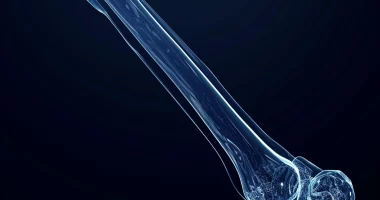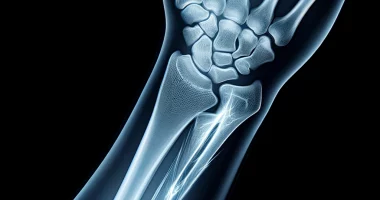Craniosynostosis
Definition
Craniosynostosis is a disease, in which main symptom is a deformity of the cerebral skull resulting from premature healing of the bony sutures. The clinical picture includes skull deformities, symptoms of intracranial hypertension, optic nerve pathology, and mental lag. Rarely, the disease is accompanied by anomalies of the bones of the facial skull. Diagnosis consists of assessing the degree of overgrowth of cranial sutures and identifying bone defects by physical examination, radiography, CT, and MRI. The main treatment is early surgical correction of the shape of the skull bones.
General information
Craniosynostosis is a pathological condition in pediatrics that occurs against the background of early overgrowth of cranial sutures, characterized by deformation of the cranial box and impaired development of brain tissue. On average, the prevalence of different forms of the disease is 0.03-3.5% of all newborns. The male sex is more prone to the development of this pathology. The most common variant is monosynostosis. Premature overgrowth of the sagittal suture (scaphocephaly) is most often observed – 50-65% of all craniosynostosis. In case of timely diagnosis and adequate treatment in the first 6-9 months of life, the patient’s further development is without abnormalities.
Causes of craniosynostosis
The exact etiology of craniosynostosis has not been established. According to the theories put forward, this disease can develop as a result of intrauterine disturbance of the child’s hormonal background, perinatal trauma, and compression of the skull bones in the uterine cavity. Also, this pathology occurs with hereditary pathologies—Apert syndrome, Crouzon syndrome, and Pfeiffer syndrome. One of the leading causes of craniosynostosis is an abnormality of the gene responsible for the formation of fibroblast growth factor receptors (FGFR).
Classification of craniosynostosis
Craniosynostosis, according to etiologic factors, is divided into two groups:
- Syndromal. In this case, the pathology is combined with other congenital malformations. It includes X-linked, monogenic, chromosomal, and other craniosynostosis.
- Non-syndromal. It is an isolated form that occurs independently and has no comorbidities.
Depending on the number of overgrown cranial sutures are distinguished:
- Monosynostosis. It is characterized by a lesion of only one suture. In the case of coronary and lambdoidal sutures, overgrowth may be uni- or bilateral. The most common form.
- Polysynostosis. 2-3 sutures are involved in the pathologic process.
- Pansynostosis. All the bony sutures of the child’s skull are fused in this form. It is extremely rare.
Symptoms of craniosynostosis
Craniosynostosis is clinically manifested from the moment of birth. All forms are characterized by plagiocephaly and early closure of the great fontanel (occurs typically at 12-18 months of age). Only in polysynostosis or concomitant hydrocephalus can it remain open until the age of 3. Also, in craniosynostosis, there is often an increase in intracranial pressure, which may be manifested by neurological disorders: restlessness, intense crying, nausea and vomiting, sleep disturbance, decreased appetite, and seizures.
Each of the forms of the disease has characteristic clinical features. Craniosynostosis of the sagittal suture (scaphocephaly or navicular skull) is characterized by an increase in the anteroposterior size of the child’s head with insufficient width and visually determined by the elongation of the skull, “overhanging” of the forehead and occipital part, narrowing of the face and its acquisition of an oval shape. During palpation of the site of the sagittal suture a bone ridge is revealed. Mental developmental delay is possible at an early age.
Overgrowth of the lambdoid suture is most often unilateral and manifested by flattening of the occipital region. It is a difficult form to diagnose since plagiocephaly is practically invisible under the hair, and neurological disorders are minimal. When the patient grows up, the disease dynamics are practically absent.
Coronal or venous craniosynostosis can be either uni- or bilateral. Overgrowth of only one-half of the suture is accompanied by a typical deformation of the child’s skull – flattening of the frontal bone and the upper part of the eye socket on the affected side. Over time, the curvature of the nose is in the opposite direction; the cheekbone is flattened, and bite disorder and strabismus develop. Bilateral coronary craniosynostosis is manifested by a broad, flat, and high forehead with flattened ocular edges of the frontal bone, rarely – tower deformation of the skull (acrocephaly). Neurologic disorders are nonspecific and similar to other forms.
Non-topic craniosynostosis or trigonocephaly is characterized by the development of a triangular forehead with a bony keel running from the glabella to the greater fontanelle. Hypotelorism is also observed – displacement of the eye sockets to the rear with decreased interorbital space. Over time, there is some smoothing of the bony ridge and normalization of the forehead shape. In half of the cases, visual impairment and mental developmental delay occur.
Syndromal craniosynostosis is the rarest and most severe form. In addition to plagiocephaly, there is dysplasia of the bones of the facial part of the skull, resulting in respiratory failure, eating disorders, and visual pathology. Characterized by synostosis of the venous suture and, as a result – brachycephalic form of the child’s head. There is also hypoplasia of the upper jaw bones, protrusion of the eyeballs from the orbits, and hypertelorism. Often, there is a significant expansion of the fontanelle and divergence of the sagittal suture. Without treatment, children develop severe mental developmental delay, often dying during the first 12 months of life from acute respiratory viral infections complicated by pneumonia.
Diagnosis of craniosynostosis
Diagnosis of craniosynostosis is based on physical examination and instrumental methods of investigation. History is often uninformative, but its data allow the pediatrician to trace the dynamics of clinical symptoms, if any. An important point is the visual inspection of the child, which makes it possible to detect characteristic deformities of the skull, bone anomalies, etc. Laboratory tests do not reveal specific changes and can be used to determine genetic pathology or diagnose complications.
Instrumental methods that allow visualizing bone deformities and assessing the degree of brain tissue damage are mandatory. These include neurosonography, radiography, computed tomography, and magnetic resonance imaging. Neurosonography is used to assess the condition of brain tissue and the size of the ventricles to detect intracranial hypertension. On the X-ray, it is possible to determine violations of bone structure, ossification of cranial sutures, and increased intracranial pressure. CT and MRI are used to obtain more informative results. If a lesion of the visual system is suspected, ophthalmoscopy is performed to detect a lesion of the optic disc. Consultations with a neurosurgeon and an ophthalmologist are recommended.
Treatment of craniosynostosis
The main treatment of craniosynostosis is surgical correction of the bony deformity of the skull. The optimal time for surgical intervention is the first 6-9 months of a child’s life. These terms are used because, during this period, the most intensive development of brain tissue occurs, which can hinder the deformation of the skull. In addition, the skull bones at this age quickly restore their structure without developing complications. The volume and technique of surgery depend on the form of craniosynostosis and associated pathologies. At 2-3 years of age, correction is carried out solely to eliminate the cosmetic defect. In addition to surgical treatment, the child’s diet is changed by age requirements. In the case of intercurrent diseases, drug therapy is indicated.
All these treatment options are available in more than 440 hospitals worldwide (https://doctor.global/results/diseases/craniosynostosis). For example, Craniosynostosis surgery can be done in 20 clinics across Turkey for an approximate price of $11.4 K (https://doctor.global/results/asia/turkey/all-cities/all-specializations/procedures/craniosynostosis-surgery).
Prognosis and prevention of craniosynostosis
The prognosis for children with craniosynostosis directly depends on the form of the disease, the timeliness of diagnosis, and the effectiveness of surgical intervention. With quality treatment, the outcome of the disease is usually favorable. A syndromal form of craniosynostosis is considered unfavorable prognostically.
There is no specific prevention for this pathology. Nonspecific measures include medical and genetic counseling of the family and pregnancy planning, protection of the woman’s health during childbearing, rational nutrition, avoidance of harmful habits, and exclusion of all potential etiologic factors of craniosynostosis development.

